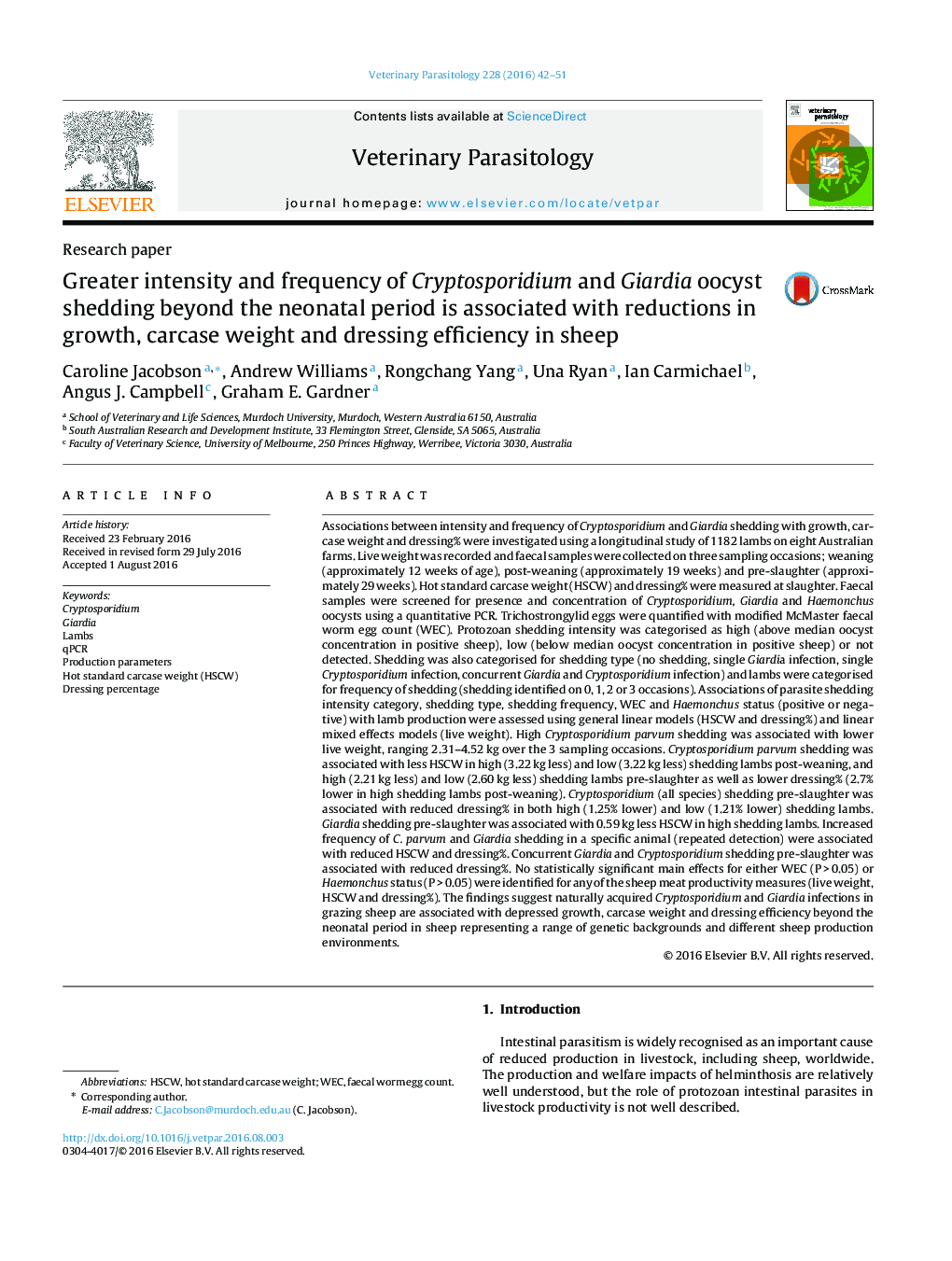| کد مقاله | کد نشریه | سال انتشار | مقاله انگلیسی | نسخه تمام متن |
|---|---|---|---|---|
| 5801942 | 1555648 | 2016 | 10 صفحه PDF | دانلود رایگان |
- High shedding intensity associated with reduced live weight and carcase productivity.
- Increased frequency of detection associated with reduced carcase productivity.
- Giardia and Cryptosporidium associated with reduced production after weaning.
- Intensity and timing of shedding relative to slaughter impact carcase outcomes.
Associations between intensity and frequency of Cryptosporidium and Giardia shedding with growth, carcase weight and dressing% were investigated using a longitudinal study of 1182 lambs on eight Australian farms. Live weight was recorded and faecal samples were collected on three sampling occasions; weaning (approximately 12 weeks of age), post-weaning (approximately 19 weeks) and pre-slaughter (approximately 29 weeks). Hot standard carcase weight (HSCW) and dressing% were measured at slaughter. Faecal samples were screened for presence and concentration of Cryptosporidium, Giardia and Haemonchus oocysts using a quantitative PCR. Trichostrongylid eggs were quantified with modified McMaster faecal worm egg count (WEC). Protozoan shedding intensity was categorised as high (above median oocyst concentration in positive sheep), low (below median oocyst concentration in positive sheep) or not detected. Shedding was also categorised for shedding type (no shedding, single Giardia infection, single Cryptosporidium infection, concurrent Giardia and Cryptosporidium infection) and lambs were categorised for frequency of shedding (shedding identified on 0, 1, 2 or 3 occasions). Associations of parasite shedding intensity category, shedding type, shedding frequency, WEC and Haemonchus status (positive or negative) with lamb production were assessed using general linear models (HSCW and dressing%) and linear mixed effects models (live weight). High Cryptosporidium parvum shedding was associated with lower live weight, ranging 2.31-4.52Â kg over the 3 sampling occasions. Cryptosporidium parvum shedding was associated with less HSCW in high (3.22Â kg less) and low (3.22Â kg less) shedding lambs post-weaning, and high (2.21Â kg less) and low (2.60Â kg less) shedding lambs pre-slaughter as well as lower dressing% (2.7% lower in high shedding lambs post-weaning). Cryptosporidium (all species) shedding pre-slaughter was associated with reduced dressing% in both high (1.25% lower) and low (1.21% lower) shedding lambs. Giardia shedding pre-slaughter was associated with 0.59Â kg less HSCW in high shedding lambs. Increased frequency of C. parvum and Giardia shedding in a specific animal (repeated detection) were associated with reduced HSCW and dressing%. Concurrent Giardia and Cryptosporidium shedding pre-slaughter was associated with reduced dressing%. No statistically significant main effects for either WEC (PÂ >Â 0.05) or Haemonchus status (PÂ >Â 0.05) were identified for any of the sheep meat productivity measures (live weight, HSCW and dressing%). The findings suggest naturally acquired Cryptosporidium and Giardia infections in grazing sheep are associated with depressed growth, carcase weight and dressing efficiency beyond the neonatal period in sheep representing a range of genetic backgrounds and different sheep production environments.
Journal: Veterinary Parasitology - Volume 228, 15 September 2016, Pages 42-51
